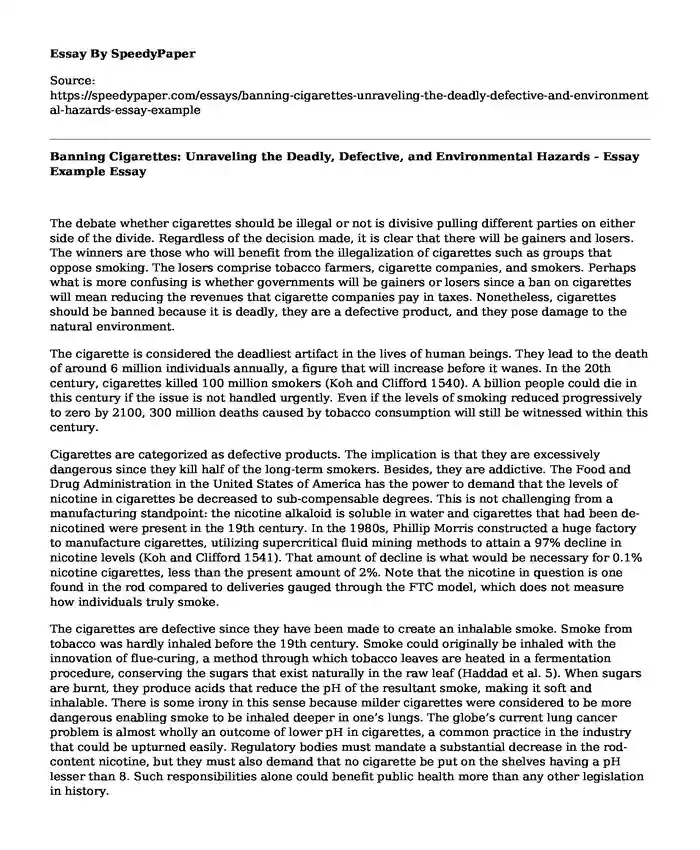
| Type of paper: | Essay |
| Categories: | Company Environment |
| Pages: | 4 |
| Wordcount: | 892 words |
The debate whether cigarettes should be illegal or not is divisive pulling different parties on either side of the divide. Regardless of the decision made, it is clear that there will be gainers and losers. The winners are those who will benefit from the illegalization of cigarettes such as groups that oppose smoking. The losers comprise tobacco farmers, cigarette companies, and smokers. Perhaps what is more confusing is whether governments will be gainers or losers since a ban on cigarettes will mean reducing the revenues that cigarette companies pay in taxes. Nonetheless, cigarettes should be banned because it is deadly, they are a defective product, and they pose damage to the natural environment.
The cigarette is considered the deadliest artifact in the lives of human beings. They lead to the death of around 6 million individuals annually, a figure that will increase before it wanes. In the 20th century, cigarettes killed 100 million smokers (Koh and Clifford 1540). A billion people could die in this century if the issue is not handled urgently. Even if the levels of smoking reduced progressively to zero by 2100, 300 million deaths caused by tobacco consumption will still be witnessed within this century.
Cigarettes are categorized as defective products. The implication is that they are excessively dangerous since they kill half of the long-term smokers. Besides, they are addictive. The Food and Drug Administration in the United States of America has the power to demand that the levels of nicotine in cigarettes be decreased to sub-compensable degrees. This is not challenging from a manufacturing standpoint: the nicotine alkaloid is soluble in water and cigarettes that had been de-nicotined were present in the 19th century. In the 1980s, Phillip Morris constructed a huge factory to manufacture cigarettes, utilizing supercritical fluid mining methods to attain a 97% decline in nicotine levels (Koh and Clifford 1541). That amount of decline is what would be necessary for 0.1% nicotine cigarettes, less than the present amount of 2%. Note that the nicotine in question is one found in the rod compared to deliveries gauged through the FTC model, which does not measure how individuals truly smoke.
The cigarettes are defective since they have been made to create an inhalable smoke. Smoke from tobacco was hardly inhaled before the 19th century. Smoke could originally be inhaled with the innovation of flue-curing, a method through which tobacco leaves are heated in a fermentation procedure, conserving the sugars that exist naturally in the raw leaf (Haddad et al. 5). When sugars are burnt, they produce acids that reduce the pH of the resultant smoke, making it soft and inhalable. There is some irony in this sense because milder cigarettes were considered to be more dangerous enabling smoke to be inhaled deeper in one’s lungs. The globe’s current lung cancer problem is almost wholly an outcome of lower pH in cigarettes, a common practice in the industry that could be upturned easily. Regulatory bodies must mandate a substantial decrease in the rod-content nicotine, but they must also demand that no cigarette be put on the shelves having a pH lesser than 8. Such responsibilities alone could benefit public health more than any other legislation in history.
Cigarettes are a major source of harm to the environment. Manufacturing cigarettes uses limited resources while growing, curing, flavoring, and other processes. Besides, it causes other dangers from the excessive use of pesticides and deforestation. Expanses of savannah woodlands are used yearly to get the charcoal utilized for flue-curing. Manufacturing of cigarettes forms greenhouse gas emissions too, mainly out of the fossil fuels utilized while curing and transportation, uncontrolled fires from poor disposal of cigarette butts, and additional medical costs from ailments brought about by smoking (Au et al. 50). China makes 40% of the globe’s cigarettes, for instance, and utilizes majorly coal for curing its tobacco leaves (Au et al. 50). Furthermore, cigarette manufacturers have offered noteworthy finances and institutional backing for those opposing climate changes, causing more harm. Cigarette smoking is unsustainable in a world beaten by global warming. Certainly, they are among the most overlooked and avoidable causes.
Conclusion
In conclusion, cigarettes should be banned because it is deadly, they are a defective product, and they pose damage to the natural environment. The cigarette is considered the deadliest object in the lives of human beings because it leads to the death of around 6 million individuals annually, a figure that will increase before it wanes. Besides, cigarettes are categorized as defective products because of the excess dangers they cause by killing half of the long-term smokers. They are also addictive owing to the high amount of nicotine. Another cause for the defectiveness of cigarettes is the inhalable smoke they produce. Initially, cigarettes did not produce smoke, and perhaps that is the direction that should be followed in the present world. pH levels within the cigarettes should also be kept at a minimum to reduce addiction rates. Lastly, cigarettes harm the environment in almost all the processes used.
Works Cited
Au, W. W., et al. "Problems with cigarette smoking and attitudes towards the ban of smoking in Shantou, China." Public Health 134 (2016): 46-53.
Haddad, Chadia, et al. "Comparing cigarette smoking knowledge and attitudes among smokers and non-smokers." Environmental Science and Pollution Research (2020): 1-11.
Koh, Howard K., and Clifford E. Douglas. "The San Francisco ban and the future of e-cigarettes." Jama 322.16 (2019): 1540-1541.
Cite this page
Banning Cigarettes: Unraveling the Deadly, Defective, and Environmental Hazards - Essay Example. (2024, Jan 04). Retrieved from https://speedypaper.net/essays/banning-cigarettes-unraveling-the-deadly-defective-and-environmental-hazards-essay-example
Request Removal
If you are the original author of this essay and no longer wish to have it published on the SpeedyPaper website, please click below to request its removal:
Popular categories




